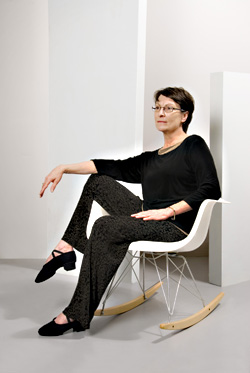Despite videotape and notation, most dances are still taught person to person, a slightly more advanced version of “monkey see, monkey do.” The repertory lives in the bones and sinews of those who perform it, which makes the historical record a fragile thing. It’s hard to revive a work even from the recent past when everyone who knew it is gone and the only evidence left is a few reviews and some photos. And it takes a special kind of obsession to keep looking backward while the rest of the dance world hurtles ahead. Which is part of what makes the project that Hannah Wiley and the University of Washington Chamber Dance Company run so special.
Wiley developed the UW’s master’s program in dance, which is designed to give performers the skills and credentials they need to teach at the college level. To take advantage of their prowess while they’re enrolled, Wiley started a new company. And taking a clue from her academic environment, she began collecting a repertory focused on the history of modern dance. Since the ensemble gave its first performances in 1990, it has performed works by the big names—Duncan, St. Denis, Graham, and Humphrey among them—but has also pursued choreography from less-well-known artists who were just as influential in their time, but who don’t have the same name recognition today. Identifying these works, and finding a way to get them staged, has made Wiley into something of a detective, searching for witnesses and clues to past times.
Michio Ito is one of those artists that Wiley has been searching for, a choreographer whose work in the 1920s was part of the early development of modern dance. Originally from Japan, he trained in eurythmy in Germany, but developed his own movement vocabulary when he came to the U.S. It includes the theatrical expressiveness that was so popular at the time, but it also reflects an austerity that likely comes from his own heritage. Ito never established an ongoing company here; so when he was deported back to Japan at the beginning of World War II, his work faded from the general memory.
In the late 1990s, Wiley set about tracing the human chain to Ito’s works, teacher to student. “At the time, Robert Tynes [a dancer affiliated with the UW] was helping me,” Wiley says. “He came up with a fellow, a restaurateur in New York City, who had learned the work. I tried to get in touch with him, but at that point he didn’t want to have anything to do with it. So we started tracking down the actual family. Ito’s granddaughter works in the arts in California, and she directed me to Taeko Furusho, who was a student of Ito’s in Japan.” Furusho was 88 at the time, and Wiley asked her to come to Seattle to re-create the work. Even though Furusho didn’t speak English and Wiley doesn’t speak Japanese, the two formed a strong attachment, Wiley says, and were able to revive “Tango” and “Five Dance Poems.”
“Ito created his own vocabulary,” says Wiley. “You can see him combining ‘male’ and ‘female’ [dance phrases] to create what feels like haiku. One thing all his students say, and the students of his students say, is that his musical landmarks and his vocabulary underlie everything, but he wanted you to breathe yourself into it,” a very American quality in modern dance. Wiley sees Ito as an early example of fusion in contemporary dance. “What’s interesting about him is the strong combination of American, European, and Japanese influences.”
CDC first performed Ito’s works in 2001, but Wiley wanted to document the pieces, along with other Chamber Dance repertory with an equally tenuous history. The result, after a multitude of grant applications and video sessions, is a new set of archive DVDs, which also explore the work of choreographers Mary Wigman and Dore Hoyer, both major influences in the development of modern dance in Germany. Wiley hopes to place the set in academic libraries, starting at the UW, alongside a growing digitized collection of Chamber Dance Company performance videos.
In the meantime, CDC is performing the Ito suite along with other works from the historic repertory for its annual show this week. Doris Humphrey, who was one of the originators of American modern dance, made “Invention” in 1949 in her signature style—lyrical but not balletic. Laura Dean makes what some people describe as postmodern folk dance, with simple steps and quiltlike patterns; her 1982 “Skylight” is an example of this variation on tradition. Zvi Gotheiner’s “Dance for Seven,” from 1986, is the most recent work on the program and an excellent example of the hybrid ballet-and-modern dances that became popular at that time. From Ito’s contemplative explorations to Gotheiner’s rich virtuosity, it’s a big—and entertaining—slice of dance history.




